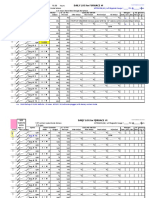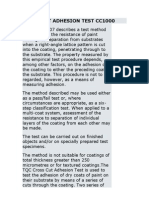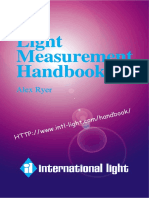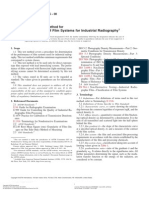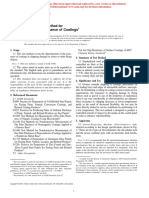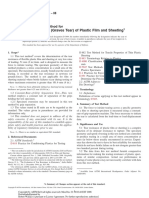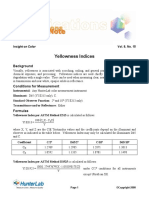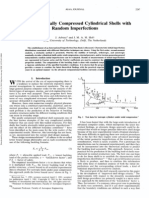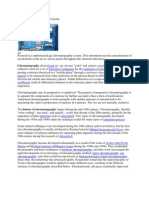Visual Color Evaluation Metamerism (Based On ASTM D-4086)
Visual Color Evaluation Metamerism (Based On ASTM D-4086)
Uploaded by
T AaaCopyright:
Available Formats
Visual Color Evaluation Metamerism (Based On ASTM D-4086)
Visual Color Evaluation Metamerism (Based On ASTM D-4086)
Uploaded by
T AaaOriginal Title
Copyright
Available Formats
Share this document
Did you find this document useful?
Is this content inappropriate?
Copyright:
Available Formats
Visual Color Evaluation Metamerism (Based On ASTM D-4086)
Visual Color Evaluation Metamerism (Based On ASTM D-4086)
Uploaded by
T AaaCopyright:
Available Formats
Best Practices For Performing
Visual Color Evaluation
Overview In order to ensure the accuracy of results, the observer
Attempting a visual color evaluation is to determine requirements must be defined and adhered.
the degree of difference between a sample’s color
and the standard color. The method for establishing • The observer must not be color blind. People
the procedure is usually straight-forward and involved with color evaluation must be tested for
simple depending on the industry or the company’s color deficiencies.
requirements. Today, many leading companies invest • Observer’s attire must be achromatic. Neutral
time and money to ensure the color of their products colors such as grey or white should be worn, to
matched all the time. minimize influencing the appearance of samples.
This is the reason color viewing light booths are
painted in neutral grey.
• No tinted glasses or contact lens are allowed
during visual assessment. This will affect the
judgement of the observer significantly.
• When conducting color inspection of a sample,
do not assess it for more than 10 seconds before
making a pass/fail judgement, because the
human eye’s sensitivity decreases with time.
Viewing Conditions
Color can be measured instrumentally or viewed Samples being evaluated must be prepared and
under controlled lightings to provide an objective color presented correctly with consistency as the viewing
evaluation. Chroma Meters and spectrophotometers orientation can affect the appearance. An object that
are used to measure color and light booths or cabinets is viewed from a slightly different angle, for example,
are often used as visual grader. A light booth is a may make the object appear brighter or darker.
lighting cabinet with standard light sources such as
D65 (Daylight 6500K), F2 (Cool White Fluorescent), • Position samples flat in the light booth or at
Illuminant A (Tungsten) or industry specified light 45 degree angle and swap their positions left
source. These light sources are useful in the evaluation to right, top to bottom to observe any color
of color and metamerism. changes.
There may be problems experienced when performing • When making comparisons between a sample
visual color evaluation. They could result from the and the standard, position them side by side so
incorrect choice or use of a light source, improper that they are parallel with each other for better
viewing conditions and observer difference. Listed color judgement.
below are some of the best practices for accomplishing
accurate results for visual assessments. • Other colors will affect the color perception.
Always perform the evaluation with a common
Observer Conditions background and keep the light booth clean. Do
All humans perceive color differently because the not place any other foreign objects in the light
sensitivity of the human eye varies from person to booth other than the samples that are being
person which often cause the perception of color to assessed so as not to affect the appearance for
appear differently to each individual. their color.
KONICA MINOLTA SENSING SINGAPORE PTE LTD
10 TEBAN GARDENS CRESCENT SINGAPORE 608923
sensing.konicaminolta.asia
Best Practices For Performing
Visual Color Evaluation
Lighting Conditions
Light sources can be specified by an industry, company or an individual when establishing a procedure for
visual assessment. A conventional light bulb can be considered an actual emitting device, although it might
not be a commonly used source for color evaluation. A light source can be considered characterized when
its spectral output has been documented. Most of the light sources in the market are characterized by the
developer or the manufacturer. Common standardized sources include:
Standardized Source Description Details
A tungsten source at a color Emits high amount of red and yellow
Illuminant A
temperature of 2856K. energy with very little blue and no UV.
Daylight source at 6770K with no UV Specifically used by the paper industry.
Illuminant C
component.
Daylight with equal amount of daylight Commonly used in the imaging industries
D50 (Daylight 5000K) (red, green and blue). Includes UV where the sample has many colors to
energy. match (eg. photograph).
Characterized by having lesser red than Extensively used for color matches and
blue energy. Spectrally complete with the detection of metamerism. It is the
D65 (Daylight 6500K)
all colors and energy down through the source of choice for instrumentation
UV region of the spectrum. applications.
Characterized by having higher amount Originally specified by the imaging
of blue energy than D65, otherwise industries to help viewers identify the
D75 (Daylight 7500K) similar. yellow ink and for color matches in the
USA. Now has been taken over by D65 for
general industrial use.
Cool White Fluorescent (CWF) with Low CRI (below 70), commonly used in
F2 single phosphor, broad halo fluorescent the USA for facility lighting applications.
source at 4100K.
Warm White Fluorescent source with Used in general lighting applications
F4 higher red energy than F2 (2940K). where a warmer lighting atmosphere is
required without the use of tungsten.
Tri-phosphor fluorescent source at Commonly used source in Europe for
F11 4100K. general lighting applications. CRI is below
85.
Standardizing lighting conditions are required to maintain consistency as different light sources often lead to
different judgement. Hence it is important to:
• Evaluate within a controlled environment of a light booth to maintain standardized lighting conditions.
• Switch off all room lighting except the light source of the light booth. This is to minimize the influence of
ambient light interference.
KONICA MINOLTA SENSING SINGAPORE PTE LTD
10 TEBAN GARDENS CRESCENT SINGAPORE 608923
sensing.konicaminolta.asia
Best Practices For Performing
Visual Color Evaluation
Test for Metamerism • For best results in a visual test, always compare the
Metamerism is a very common problem, though most samples using three light sources. Incandescent
people do not realize this. It occurs when a pair of for its high red energy content, D65 for its high
sample is deemed to match under one light source blue energy and CWF for its high green energy.
but not under another. This happens when the color • It is important that metamerism is identified and
batch or recipe for dyes, paints, inks or other pigments kept to a minimum using a light booth. In some
is changed during production, leading to a mismatch cases, an instrument test is performed using a
of colors. spectrophotometer to confirm the presence of
this phenomenon.
Metameric effects are best observed under two or
more different light sources and illuminants such as You may be doing visual evaluation correctly but is the
daylight (D65) and incandescent light (illuminant A). person you communicate with doing it right? Are they
Visual test can be conducted using the following steps: using the same light sources and evaluation methods?
Make sure that good practices and procedures are in
• Visually compare a pair of metameric sample place within the organization as these will save you
under one light source within the light booth. countless hours and money.
• Change the light source, for example D65 to
illuminant A, and observe the samples for any To know more information on the proper tools and
color mismatch. evaluation procedures, you can contact Konica Minolta
• Samples are considered metameric if they match Sensing Singapore Pte Ltd at 6563 5533 or email us at
under one light source but not under another. ssg@konicaminolta.sg.
KONICA MINOLTA SENSING SINGAPORE PTE LTD
10 TEBAN GARDENS CRESCENT SINGAPORE 608923
sensing.konicaminolta.asia
You might also like
- ASTM D-3985-02e1 (O2TR) PDFDocument6 pagesASTM D-3985-02e1 (O2TR) PDFT Aaa100% (1)
- Water Fuel Cell - Build Manual - Tap Water (Daves Stanley Meyer Xogen Free Energy)Document10 pagesWater Fuel Cell - Build Manual - Tap Water (Daves Stanley Meyer Xogen Free Energy)andr3y775% (4)
- Crack Filler, Hot-Applied, For Asphalt Concrete and Portland Cement Concrete PavementsDocument3 pagesCrack Filler, Hot-Applied, For Asphalt Concrete and Portland Cement Concrete Pavementsahmad waleedNo ratings yet
- GMW14698 ArranhõesDocument7 pagesGMW14698 ArranhõesRicardo F. SNo ratings yet
- D 3451 - 92 - Rdm0ntetukveDocument27 pagesD 3451 - 92 - Rdm0ntetukveEmre DalgicNo ratings yet
- Worldwide Engineering Standards: Stone Impact Resistance of CoatingsDocument3 pagesWorldwide Engineering Standards: Stone Impact Resistance of CoatingsAnvarbek KarimovNo ratings yet
- Ghs Poster EuDocument2 pagesGhs Poster EuCristiano Brida100% (1)
- ASTM D5894 - 05 Cyclic Salt FogUV Exposure of Painted Metal, (Alternating Exposures in A FogDry Cabinet and A UVCondensation Cabinet)Document3 pagesASTM D5894 - 05 Cyclic Salt FogUV Exposure of Painted Metal, (Alternating Exposures in A FogDry Cabinet and A UVCondensation Cabinet)AlineMeirelesNo ratings yet
- ASTM D-1894-09 (Friction Coefficient of Plastic Film) PDFDocument8 pagesASTM D-1894-09 (Friction Coefficient of Plastic Film) PDFT AaaNo ratings yet
- ASTM D-6988-13 (Thickness of Plastic Film)Document7 pagesASTM D-6988-13 (Thickness of Plastic Film)T Aaa100% (2)
- ASTM D-1895 測定装置Document2 pagesASTM D-1895 測定装置T Aaa0% (1)
- 901-01164-A07 S8 Exp Technical SpecificationsDocument10 pages901-01164-A07 S8 Exp Technical Specificationsgerardo amaya100% (1)
- Identifying The Proper Instrument Geometry For Measuring Metallic InksDocument11 pagesIdentifying The Proper Instrument Geometry For Measuring Metallic Inkskillan adishonNo ratings yet
- Mastersizer PDFDocument20 pagesMastersizer PDFSilvia RinconNo ratings yet
- Sheen Catalogue 2009 RebrandDocument43 pagesSheen Catalogue 2009 RebrandMoatz HamedNo ratings yet
- The Optics of SpectrosDocument61 pagesThe Optics of SpectrosudacurieNo ratings yet
- Visual Color Assessment FormDocument1 pageVisual Color Assessment FormKonica Minolta Sensing Singapore Pte LtdNo ratings yet
- Oven Heat Stability of Poly (Vinyl Chloride) Compositions: Standard Practice ForDocument3 pagesOven Heat Stability of Poly (Vinyl Chloride) Compositions: Standard Practice ForDiego100% (1)
- Assignment # 1Document11 pagesAssignment # 1Shoaib Wahab100% (1)
- ASTM D2244-07 Calculation of Color Tolerances and Color Differences From Measured Color CoordinatesDocument10 pagesASTM D2244-07 Calculation of Color Tolerances and Color Differences From Measured Color CoordinatesFilthynotesNo ratings yet
- Instruments For Color Measurement PDFDocument11 pagesInstruments For Color Measurement PDFJuan Cubas100% (1)
- Furnace Log 102410Document54 pagesFurnace Log 102410William RichardsonNo ratings yet
- Specular Gloss: Standard Test Method ForDocument5 pagesSpecular Gloss: Standard Test Method ForSgjsevenpNo ratings yet
- d1653 Water Vapor Transmission of Organic Coating Films1Document5 pagesd1653 Water Vapor Transmission of Organic Coating Films1caronieblesNo ratings yet
- Standard Test Method ForDocument5 pagesStandard Test Method ForFelma Grace De LeonNo ratings yet
- Astm D 1148Document4 pagesAstm D 1148arthymanicNo ratings yet
- ASTEM D955 00 - Standard Test Method of Measuring Shrinkage From Mold Dimensions of Thermoplastics PDFDocument5 pagesASTEM D955 00 - Standard Test Method of Measuring Shrinkage From Mold Dimensions of Thermoplastics PDFAndre Rodriguez Spirim100% (1)
- Cross Cut Adhesion Test Cc1000Document9 pagesCross Cut Adhesion Test Cc1000gialadasNo ratings yet
- D3359 Standard Test Methods For Rating Adhesion by Tape Test1 PDFDocument9 pagesD3359 Standard Test Methods For Rating Adhesion by Tape Test1 PDFraulpalma93No ratings yet
- Resistance To Fuels of Exteriors Automotive Materials and ComponentsDocument6 pagesResistance To Fuels of Exteriors Automotive Materials and ComponentsAnvarbek KarimovNo ratings yet
- Light Measurement Handbook PDFDocument64 pagesLight Measurement Handbook PDFAnonymous Heg7II100% (1)
- 3 6077 RTVDocument2 pages3 6077 RTVgkretroNo ratings yet
- Characterization of Coatings Using Conformable Eddy-Current Sensors Without Coating Reference StandardsDocument8 pagesCharacterization of Coatings Using Conformable Eddy-Current Sensors Without Coating Reference StandardsChristopheNo ratings yet
- Part 1 - General: Coatings Manual HRSD Section 7 Standard Coatings SpecificationsDocument49 pagesPart 1 - General: Coatings Manual HRSD Section 7 Standard Coatings SpecificationswilliamjdtNo ratings yet
- D5412 PDFDocument10 pagesD5412 PDFZamir Danilo Morera Forero100% (1)
- Quality Department Annual PlanDocument24 pagesQuality Department Annual PlanKumaravelNo ratings yet
- E313 Standard Practice For Calculating Yellowness and Whiteness Indices From Instrumentally Measured Color CoordinatesDocument6 pagesE313 Standard Practice For Calculating Yellowness and Whiteness Indices From Instrumentally Measured Color CoordinatesCalidad EquisplastNo ratings yet
- Iso 15105-2-2003Document20 pagesIso 15105-2-2003Sorin SorinNo ratings yet
- Adhesion Testing, Adhesive TestingDocument3 pagesAdhesion Testing, Adhesive TestingLabthinkchinaNo ratings yet
- Abrasion Resistance of Printed Materials by The Sutherland Rub TesterDocument3 pagesAbrasion Resistance of Printed Materials by The Sutherland Rub TesterlexandroNo ratings yet
- 181 - DE0521 Paint Standard Rev81Document5 pages181 - DE0521 Paint Standard Rev81Moeen Khan RisaldarNo ratings yet
- Param XLW (PC) Auto Tensile Tester: ProfessionalDocument3 pagesParam XLW (PC) Auto Tensile Tester: ProfessionalAamirMalik100% (1)
- DSC PresentationDocument11 pagesDSC Presentationhareesh13h100% (1)
- 18-ASTM E2174-14bDocument7 pages18-ASTM E2174-14bAli Adnaan RazaNo ratings yet
- ASTM E 1815 - 2008 Classification of Film Systems For Industrial Radiography1Document8 pagesASTM E 1815 - 2008 Classification of Film Systems For Industrial Radiography1grimaguilNo ratings yet
- Grey Scale For Assessing Change in ShadeDocument2 pagesGrey Scale For Assessing Change in ShadevinayakasisNo ratings yet
- Automated Detection of Internal Decay in Wooden Utility PolesDocument9 pagesAutomated Detection of Internal Decay in Wooden Utility PolesAbhi LashNo ratings yet
- Resistance of Organic Coatings To The Effects of Rapid Deformation (Impact)Document3 pagesResistance of Organic Coatings To The Effects of Rapid Deformation (Impact)hernando gelvesNo ratings yet
- D 3170 - 01 - RdmxnzatmdeDocument10 pagesD 3170 - 01 - RdmxnzatmdeEmre DalgicNo ratings yet
- Encapsulated Sample Rheometer (Premier ESR)Document10 pagesEncapsulated Sample Rheometer (Premier ESR)Amie SedlockNo ratings yet
- 3LPE Coating Performance in IranDocument3 pages3LPE Coating Performance in IranJorge Suarez100% (1)
- Enclosed Carbon-Arc Exposure Tests of Paint and Related CoatingsDocument6 pagesEnclosed Carbon-Arc Exposure Tests of Paint and Related CoatingsProvocateur SamaraNo ratings yet
- ASTM E-179-96 (Selection of Geometric Conditions For Measurement Of) PDFDocument6 pagesASTM E-179-96 (Selection of Geometric Conditions For Measurement Of) PDFT AaaNo ratings yet
- Film Hardness by Pencil Test: Standard Test Method ForDocument3 pagesFilm Hardness by Pencil Test: Standard Test Method ForNameNo ratings yet
- Astmd2244 23Document12 pagesAstmd2244 23Tatiana ViannaNo ratings yet
- Mastersizer 3000 User Manual English MAN0474!2!1Document182 pagesMastersizer 3000 User Manual English MAN0474!2!1Cliver Santos Yupanqui MachacaNo ratings yet
- Executive Summary: S.No. Content Learning OutcomeDocument3 pagesExecutive Summary: S.No. Content Learning Outcomesumit_waghmareNo ratings yet
- Ta Astm-6083Document8 pagesTa Astm-6083lthyaguNo ratings yet
- Visual Evaluation of Metamerism: Standard Practice ForDocument2 pagesVisual Evaluation of Metamerism: Standard Practice ForAlbulena BilalliNo ratings yet
- NDT - Concrete Investigation SlideDocument26 pagesNDT - Concrete Investigation SlideJohn OLiver100% (1)
- Astm D 904 - 99 - RdkwnaDocument3 pagesAstm D 904 - 99 - RdkwnaSamuel Eduardo0% (1)
- D1535-1989 Specifying Color by The Munsell SystemDocument29 pagesD1535-1989 Specifying Color by The Munsell SystemEdwin R RuizNo ratings yet
- Visual Color Evaluation Metamerism (Based On ASTM D-4086) PDFDocument3 pagesVisual Color Evaluation Metamerism (Based On ASTM D-4086) PDFT AaaNo ratings yet
- Colour Science 2Document149 pagesColour Science 2awaismehmoodkhan.213No ratings yet
- Visual Examination of Small ColorDocument5 pagesVisual Examination of Small Colorraghib2111No ratings yet
- End Use Brochure Coatings 2018 enDocument40 pagesEnd Use Brochure Coatings 2018 enRuselkis FloresNo ratings yet
- ASTM D-1004-08 (Tear Resistance (Graves Tear) of Plastic Film and Sheeting) PDFDocument4 pagesASTM D-1004-08 (Tear Resistance (Graves Tear) of Plastic Film and Sheeting) PDFT Aaa100% (1)
- ASTM E-179-96 (Selection of Geometric Conditions For Measurement Of) PDFDocument6 pagesASTM E-179-96 (Selection of Geometric Conditions For Measurement Of) PDFT AaaNo ratings yet
- ASTM D-1004-08 (Tear Resistance (Graves Tear) of Plastic Film and Sheeting)Document4 pagesASTM D-1004-08 (Tear Resistance (Graves Tear) of Plastic Film and Sheeting)T AaaNo ratings yet
- Intertek Flexible PachaingDocument2 pagesIntertek Flexible PachaingT AaaNo ratings yet
- ASTM D-3786-01 (Mullen Bursting Test) PDFDocument4 pagesASTM D-3786-01 (Mullen Bursting Test) PDFT Aaa50% (2)
- Visual Color Evaluation Metamerism (Based On ASTM D-4086) PDFDocument3 pagesVisual Color Evaluation Metamerism (Based On ASTM D-4086) PDFT AaaNo ratings yet
- ASTM D-1003-07 (Haze of Transparent Plastics)Document7 pagesASTM D-1003-07 (Haze of Transparent Plastics)T AaaNo ratings yet
- Yellowness IndexDocument2 pagesYellowness IndexT AaaNo ratings yet
- ASTM D-542-00 (Index of Refraction of Transparent Organic Plastics)Document4 pagesASTM D-542-00 (Index of Refraction of Transparent Organic Plastics)T AaaNo ratings yet
- ASTM D-7490-13 (Contact Angle)Document5 pagesASTM D-7490-13 (Contact Angle)T Aaa0% (1)
- ASTM F-1842-97 (Tape Test)Document3 pagesASTM F-1842-97 (Tape Test)T Aaa100% (2)
- Warframe (Critique Copy)Document33 pagesWarframe (Critique Copy)KibblesnbitsNo ratings yet
- Fundamentals of GD&TDocument7 pagesFundamentals of GD&TPalani TrainerNo ratings yet
- Column FoundationDocument21 pagesColumn Foundationvijay10484No ratings yet
- Installation Manual - Brazed Heat Exchangers - UKDocument2 pagesInstallation Manual - Brazed Heat Exchangers - UKesteban vasquezNo ratings yet
- Elastic Stability of Thin - Walled Cylindrical and Conical Shells Under Axial CompressionDocument10 pagesElastic Stability of Thin - Walled Cylindrical and Conical Shells Under Axial CompressionChandra PrakashNo ratings yet
- 1 DE CFD IntroductionDocument38 pages1 DE CFD IntroductionDiya ShettyNo ratings yet
- Concrete Mix DesignDocument4 pagesConcrete Mix DesignZakir AliNo ratings yet
- CR 2Document88 pagesCR 2Durga ReddyNo ratings yet
- Liquid LensDocument6 pagesLiquid Lenslithesh kumarNo ratings yet
- Lect 6 Steam EngineDocument23 pagesLect 6 Steam EnginemechNo ratings yet
- 33-Gustafson and Quiroga G.-1995Document15 pages33-Gustafson and Quiroga G.-1995Diana Oshin Fig NavNo ratings yet
- Mechanical Datasheet of Black Product (Fuel Oil) Road Tanker Unloading Pump (P-332, P-336)Document4 pagesMechanical Datasheet of Black Product (Fuel Oil) Road Tanker Unloading Pump (P-332, P-336)Gop MangukiyaNo ratings yet
- From WikipediaDocument4 pagesFrom WikipediazohaimranNo ratings yet
- Applications of Data Mining Theory in ElectricalDocument5 pagesApplications of Data Mining Theory in ElectricalRaviYadavNo ratings yet
- Cobalt in GlassDocument11 pagesCobalt in GlassNUR HIDAYAHNo ratings yet
- Last Name, First CHE426:: F C V C V C F + F F CDocument6 pagesLast Name, First CHE426:: F C V C V C F + F F Clợi trầnNo ratings yet
- Week09 Transmission Line Modeling-Ver2Document25 pagesWeek09 Transmission Line Modeling-Ver2Estika Vriscilla GintingNo ratings yet
- Magnetic Effects Class 10 Cbse NotesDocument20 pagesMagnetic Effects Class 10 Cbse NotesAsmita PandeyNo ratings yet
- Lista 4-Atividades Resolvidas: Bueno BuoroDocument6 pagesLista 4-Atividades Resolvidas: Bueno BuoroThierry RodriguesNo ratings yet
- MAT1332 Midterm 2014 PracitceDocument2 pagesMAT1332 Midterm 2014 Pracitceexamkiller100% (1)
- Gland Seal Water SPOOL 1.5": AREA: 3510Document12 pagesGland Seal Water SPOOL 1.5": AREA: 3510JHONATAN RODRIGUEZ VENTONo ratings yet
- Richter ISRR13Document16 pagesRichter ISRR13AmanNo ratings yet
- Assignment QuantizationDocument2 pagesAssignment QuantizationArunabh GhoshNo ratings yet
- Four-Cable-Driven Parallel RobotDocument6 pagesFour-Cable-Driven Parallel RobotRAZIQ YOUSSEFNo ratings yet
- Failure TheoriesDocument39 pagesFailure Theoriesmarwan alobaidiNo ratings yet
- A Novel Design of The Roots BlowerDocument13 pagesA Novel Design of The Roots BlowerAsistencia Técnica JLFNo ratings yet





















